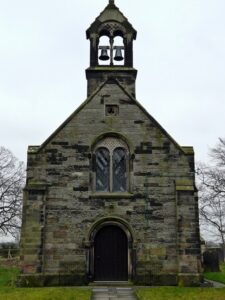In 1086 Pipe Ridware was known as Media or Parva Ridware and was held under the King by the Bishop of Chester, and under the latter by Alfric. Stebbing Shaw thinks it likely that ‘Alfric had succeeded his Saxon ancestors in the tenure under the bishop; consequently that no change, either of lord or vassal took place in this Ridware at the Conquest’. Similarly, across the river in Handsacre, the Saxon lords held the manor under the Bishop of Chester. Stebbing Shaw speculates that these two manors may have been the remnants of an older political unit which controlled and defended the Trent crossings.
The Domesday Book records land for one plough in Pipe Ridware. Later documentation however indicates that other landowners including the Earl of Stafford in 1393 and William de Handsacre had claims to land within the manor.
The name is derived from the family of Pipe who came into the manor in 1286 by the marriage of Maud, the daughter of Thomas de Thamenhorne to Robert de Pipe. In 1443 the manor passed into the Vernon family of Haddon and Harlaston through marriage and then into the Chadwick family. In 1614 John Chadwick ‘gave his said manor and fishery to Henry Agarde of Kings Bromley, esq. in exchange for certain lands in Mavesyn Ridware and a fishery in the said river within Armitage and Handsacre’.
According to Stebbing Shaw:
‘There seems reason to believe that the ancient manorial hall was not situate on the Trent, but at or near Linacre by …deed in 1319…it is likely, the place afterwards named Quinten’s Orchard, as it continues to be, from the farmers or occupiers of that name living there in 1606, and afterwards; and near this farm house, which is not distant from a field still bearing the name of Linacre, is the appearance of a small ancient moat, with extensive adjoining orchards, along the bottom of which, tradition says, the principal road to Lichfield passed anciently.’
The present farmhouse at Pipe Ridware dates from the 19th century, replacing a timber-framed building constructed by John Whitehall in the late 17th century (illustrated in Stebbing Shaw). John Whitehall was a noted apiarist, utilising a wide variety of hives. The remains of his wall-mounted hives or beeboles, can still be seen. On the same site are the remains of a dovecote, which survives from the former manor house.
The Whitehall family owned the manor of Pipe Ridware from approximately 1680-1720. Two daughters of James Whitehall, son of John, were raised by their maiden aunts, Frances and Bridget, after they were orphaned, and fascinating household account books survive from this period in the Stafford Record Office. The two girls made prestigious marriages into the Littleton and Leigh families. Frances Whitehall Littleton was the mother of the famous Staffordshire MP and foxhunter, Sir Edward Littleton, who died in 1812.
Between the church and the farmhouse is Wheelwright’s House, which was probably built at the beginning of the 17th century. This is a listed building, consisting of a timber-framed lath and plaster panel construction, with a baffle entry and inglenook. It is typical of the great rebuilding which occurred in the decades before the Civil War.
On the other side of the road from the church is Littleton House, formerly the Littleton Arms public house. In 1834 John Newman was named as a victualler in the Trade Directory. Since known establishments were listed under the landlord’s names as victuallers, it seems reasonable to assume that Mr Newman sold beer. In 1850 the victualler at Pipe Ridware was Robert Bradbury and by 1854 it was listed as the Littleton Arms. It was de-licensed in 1919 for being a ‘disorderly house’. The story goes that the Rev Sampson, the Rector of St James Church, grew increasingly annoyed about the noisy carousing across the road. The matter appeared to come to a head when one of the customers threw a tankard at the church bell when a service was being held! You can still see on the wall of the house the inscription in large letters ALL KINDS OF….. perhaps the last, now vanished, word was ALES?

St James Church was built in 1842 to replace a church on the same site that was probably constructed in or around 1638. The present chancel was built in 1898 and was designed by Aldrid Scott, a famous ecclesiastical architect of the day. An ancient font, thought to be of Saxon origin, was moved to the church of St Michael at Hamstall Ridware.
The population over the years has always been small; the 1662 Hearth Tax returns show that Pipe Ridware had 28 hearths. Census returns for 1831 give a population of 111 and for 1841 only 100.
In the Civil War Captain Watson had a troop of horse quartered here as evidenced by the following letter:
‘These are to charge and command you to bringe to my quarters att Pipe Ridware, such provision of horse meate, and mens meate, as shall be sufficient for a troope containing the number of 60; that is to say, beife, mutton, bread, veale &c. and for every horse a peck of provender a day, and for every day a load of hay. You are to bring in your week’s provision on Thursday next; fail not at your perill.
Daniell Wattson Pipe Ridware, April 28, 1646’.